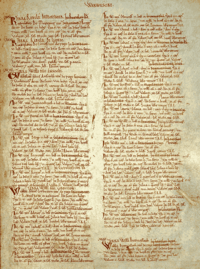| Domesday Book, 1086 |
Before and after the Norman Conquest of 1066, the village of Sutton (as it was then known) was part of a Royal Manor. This is recorded in the Domesday Book (complied in 1086), in the following entry:
The King holds DORCHESTER, FORDINGTON, SUTTON [Poyntz], GILLINGHAM and `FROME'. King Edward held them.
It is not known how many hides are there because they did not pay tax before 1066.
Land for 56 ploughs. In lordship 7 ploughs; 20 slaves; 12 freedmen; 114 villagers and 89 smallholders who have 49 ploughs.
12 mills which pay £6 5s; meadow, 160 acres; pasture 2 leagues long and 1 wide; woodland 4 leagues long and 1 league wide. 5 cobs; 20 cattle; 72 pigs; 800 sheep; 40 goats.
This manor with its dependencies pays one night's revenue.
| Page from Domesday Book |
The meaning of this entry is that both King Edward the Confessor, before the Conquest, and King William after the Conquest held the manors listed direct, so that rents from the farmers and millers in those places would come straight into the royal exchequer, rather than through a land-holder (i.e. Lord of the Manor). The place called Frome is not clearly identified, but may be near West Stafford. This grouping was one of three 'Royal Manors' of similar size in Dorset - it seems likely that the rather strange grouping of places into units was to equalise the groupings in terms of size, so that they could all pay "one night's revenue", which literally means enough to keep the King and his retinue for one night.
Because Sutton was listed as part of a large grouping, we cannot say anything at all about the number of people, ploughs and mills in Sutton at this time.
| Saxon times |
The first written record of Sutton dates from AD 891. In this year, a Saxon deed records that Alfred, King of Wessex, exchanged land with one of his Counts, Behrtwulf. This Berhtwulf may have been the same person as a nobleman called Bertulf, from Essex, whose death is recorded in the Anglo-Saxon Chronicle in 897AD.
In exchange for Plush in Dorset, and land at Raddington in Somerset, the King obtained Sutton. This is presumably when Sutton became a Royal Manor for the first time.
| After Domesday Book |
After the Domesday Book in 1086, Sutton and Preston disappear from the record for over 100 years, until 1212, when an Exchequer document (the 'Testa de Nevill') says that Nicholas Poyntz holds the manor of Sutton, with the Duke of Gloucester as the land-holder in chief. There appears to be no evidence at all about when the King gave away the manor. Kings were in the habit of rewarding good service to the crown (for example in battle) by the gift of land (remember that in Feudal England, the land was almost all owned by the King, and granted for a 'Fee' to the land-holder. The Fee was often in the form of military service, but could take many other forms). Kings were also in the habit of punishing poor behaviour by the withdrawal of land-holding rights. So some time between 1086 and 1212, the Manor of Sutton Poyntz was granted to someone, but we do not have any clear evidence of when or who. For more discussion on this, see the section on the Poyntz family.

